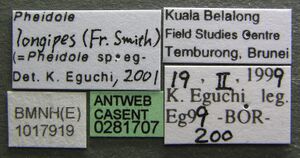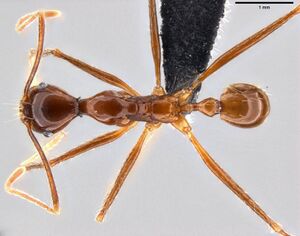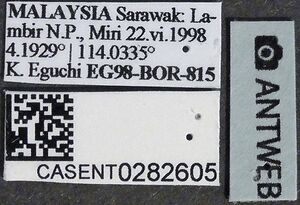Pheidole singaporensis
| Pheidole singaporensis | |
|---|---|

| |
| Scientific classification | |
| Kingdom: | Animalia |
| Phylum: | Arthropoda |
| Class: | Insecta |
| Order: | Hymenoptera |
| Family: | Formicidae |
| Subfamily: | Myrmicinae |
| Tribe: | Attini |
| Genus: | Pheidole |
| Species: | P. singaporensis |
| Binomial name | |
| Pheidole singaporensis Özdikmen, 2010 | |
| Subspecies | |
| |
| Synonyms | |
| |
Maruyama et al. (2023) found P. singaporensis nesting at the base of a large living tree in Thailand while Eguchi (2001) found it inhabiting well-developed forests and nesting in rotting fallen logs on the forest floor.
Identification
Eguchi (2001) - This species is closely related to Pheidole comata and Pheidole montana, and these three are peculiar among Indo-Chinese and Indo-Malayan congeners in the characteristics noted under P. comata. This species is distinguished from related species by the characteristics noted under P. comata and P. montana.
Keys including this Species
- Key to Pheidole majors and minors of Borneo
- Key to Pheidole majors of Borneo
- Key to Pheidole minors of Borneo
Distribution
Latitudinal Distribution Pattern
Latitudinal Range: 32.628611° to 3.439167°.
| North Temperate |
North Subtropical |
Tropical | South Subtropical |
South Temperate |
- Source: AntMaps
Distribution based on Regional Taxon Lists
Indo-Australian Region: Borneo, Indonesia, Malaysia, Philippines, Singapore (type locality).
Oriental Region: India, Myanmar, Nicobar Island, Pakistan, Thailand.
Palaearctic Region: China.
Distribution based on AntMaps
Distribution based on AntWeb specimens
Check data from AntWeb
Countries Occupied
| Number of countries occupied by this species based on AntWiki Regional Taxon Lists. In general, fewer countries occupied indicates a narrower range, while more countries indicates a more widespread species. |

|
Estimated Abundance
| Relative abundance based on number of AntMaps records per species (this species within the purple bar). Fewer records (to the left) indicates a less abundant/encountered species while more records (to the right) indicates more abundant/encountered species. |

|
Biology
Assocation with Other Species
- This species is a host for the hydrophilid beetle Chimaerocyon shimadai (a myrmecophile) in Malaysia (Fikáček et al., 2013; Maruyama et al., 2023).
- This species is a host for the Carabid beetle Cryptocephalomorpha siamensis (a myrmecophile) in Thailand (Maruyama et al., 2016; Maruyama et al., 2023).
- This species is a host for the tenebrionid beetle Platybolium watanai (a myrmecophile) in Thailand (Maruyama et al., 2023) (found at entrance of a Pheidole singaporensis nest at the base of a large living tree).
Castes
Images from AntWeb

| |
| Syntype of Myrmica longipes. Worker. Specimen code casent0901398. Photographer Ryan Perry, uploaded by California Academy of Sciences. | Owned by OUM, Oxford, UK. |
   
| |
| Worker (major/soldier). Specimen code casent0281707. Photographer Estella Ortega, uploaded by California Academy of Sciences. | Owned by NHMUK, London, UK. |
   
| |
| Worker. Specimen code casent0281707. Photographer Estella Ortega, uploaded by California Academy of Sciences. | Owned by NHMUK, London, UK. |
   
| |
| Not Provided. Worker. Specimen code casent0282605. Photographer Adam Lazarus, uploaded by California Academy of Sciences. | Owned by EPEC. |
Nomenclature
The following information is derived from Barry Bolton's Online Catalogue of the Ants of the World.
- longipes. Myrmica longipes Smith, F. 1857a: 70, pl. 1, fig. 6 (w.) SINGAPORE. Combination in Ischnomyrmex: Mayr, 1862: 739; Emery, 1922e: 114; in Aphaenogaster: Emery, 1895k: 470; Bingham, 1903: 272; in Pheidole (Isopheidole): Forel, 1912m: 765; in P. (Ischnomyrmex): Forel, 1913k: 49; Viehmeyer, 1914d: 608; in Pheidole: Bolton, 1995b: 324. Crawley, 1924: 391 (s.q.m.); Wheeler, G.C. & Wheeler, J. 1953b: 80 (l.). Unresolved junior secondary homonym of Formica longipes Latreille, above: Bolton, 1995b: 324. Replacement name: singaporensis Özdikmen, 2010b: 804. See also: Eguchi, 2001b: 71.
- singaporensis. Pheidole singaporensis Özdikmen, 2010b: 804. Replacement name for Myrmica longipes Smith, F. 1857a: 70. [Junior secondary homonym of Formica longipes Latreille, 1802c: 233.] Current subspecies: nominal plus conicollis, continentis (unresolved junior homonym), pseudola.
Type Material
Eguchi (2001) - Minor (The Natural History Museum). Type locality: Singapore. One syntype (minor) was examined.
The following notes on F. Smith type specimens have been provided by Barry Bolton (details):
Myrmica longipes
Three worker syntypes in Oxford University Museum of Natural History. Card with two syntypes labelled “Sing. 28,” card with a single syntype labelled “Singapore, Wallace.”
Description
Worker
Eguchi (2001) - Major (n=32): TL 6.8-7.9 mm, HL 2.38-3.03 mm, HW 2.05-2.73 mm, SL 1.50-2.08 mm, FL 2.33-3.35 mm, Cl 84-98, Sl 63-96, FI 98-152. Head broadest at 2/3-3/4 distance of head (as measured from the mid-point of a transverse line spanning the anteriormost and posteriormost projecting points, respectively) posterior margin of head in full-face view with a median emargination from which a shallow longitudinal impression extends to midlength of head (Fig. 25A); head in profile not impressed on vertex (Fig. 25B). Hypostoma bearing an inconspicuous median process, or lacking median processes. Clypeus with a median longitudinal carina, with anterior margin hardly emarginate medially. Eye situated around 1/3 distance of head; distance between mandibular insertion and anterior margin of eye 1.5-1.7 times as long as maximal diameter of eye. Frontal carina and antennal scrobe present only around antennal insertion. Antenna without conspicuous club; scape extending backward to 2/3-9/10 distance of head. Masticatory margin of mandible with apical and preapical teeth, and a denticle in front of basal angle. Promesonotal dome with a distinct prominence on its posterior declivity (Fig. 25C); the prominence in anterior view not or very weakly concave medially. Mesopleuron with an indistinct transverse impression. Propodeal spine corniform, 2.5-3 times as long as diameter of propodeal spiracle. Petiole in profile cuneiform, 1.0-1.1 times as long as postpetiole, with ill-defined node of which apex in posterior view is distinctly concave. Postpetiole in dorsal view subpentagonal, 2.0-2.2 times as broad as petiole.
Frons and gena longitudinally rugose; fine longitudinal rugulae curving outward on occipital lobes; lateral face of occipital lobe finely and weakly rugose with punctured interspaces, or smooth and shining over the surface; median portion of dorsolateral face of head rugoso-reticulate with enclosures punctured and dull; promesonotal dome smooth and shining, or in dorsal view weakly transversely rugose, with smooth and shining interspaces; remainder of alitrunk weakly punctured and smooth and shining partly, or weakly rugoso-reticulate, with punctured and dull enclosures; petiole (excluding smooth and shining anterodorsal face), postpetiole and first gastral tergite punctured and dull. Head in profile sparsely bearing standing hairs dorsally, and in full-face view bearing appressed pubescence, but lacking standing hairs (sometimes sparsely with them only on lateral face of occipital lobe) (Fig. 25A); outer face of mandible sparsely covered with appressed hairs, which are 0.03-0.06 mm in length and much shorter than distance between piligerous hairs; submarginal zone of masticatory margin of mandible with a row of longer decumbent hairs; in profile dorsum of promesonotal dome in front of the prominence on its posterior declivity bearing less than 10 standing hairs (Fig. 25C). Body reddish-brown to dark reddish-brown; flagella and legs lighter than alitrunk.
Minor (n=62): TL 4.1-5.1 mm, HL 1.04-1.54 mm, HW 0.66-0.93 mm, SL 1.67-2.38 mm, AL 1.50-2.11 mm, FL 2.10-3.04 mm, CI 58-70, SI 196-293, FI 247-372. Head in full-face view narrowed and prolonged behind eyes; occipital carina forming a distinct flange (Fig. 250, E). Clypeus sometimes with a longitudinal median carina, with anterior margin slightly convex or truncate medially. Eye situated at about 4/9 distance of head (as measured from anterior margin of clypeus to occipital carina); distance between mandibular insertion and anterior margin of eye 0.9-1.0 times as long as maximal diameter of eye. Antenna without conspicuous club (Fig. 25F), but 8th segment 1.3-1.4 times as long as 7th. Promesonotal dome with a distinct prominence on its posterior declivity (Fig. 25G). Mesopleuron without distinct transverse impression. Propodeal spine 2-2.5 times as long as diameter of propodeal spiracle. Petiole in profile cuneiform, with ill-defined node, 0.9-1.0 times as long as postpetiole. Postpetiole 2.0-2.3 times as broad as petiole, in dorsal view distinctly longer than broad, gently narrowed forward in its anterior 2/3.
Clypeus smooth and shining, or slightly punctured and with several rugulae; remainder of head and promesonotal dome smooth and shining; mesopleuron and lateral face of propodeum punctured (occasionally smooth and shining partly); lateral faces of petiole and postpetiole weakly punctured; dorsa of petiole and postpetiole, and gaster smooth and shining. Body brown to dark brown (rarely light brown); legs lighter than alitrunk.
References
- Bingham, C. T. 1903. The fauna of British India, including Ceylon and Burma. Hymenoptera, Vol. II. Ants and Cuckoo-wasps. London: Taylor and Francis, 506 pp. (page 272, Combination in Aphaenogaster)
- Crawley, W. C. 1924a. Ants from Sumatra, with biological notes by Edward Jacobson. Ann. Mag. Nat. Hist. 9(13): 380-409 (page 391, soldier, queen, male described)
- Eguchi, K. 2001a. A revision of the Bornean species of the ant genus Pheidole (Insecta: Hymenoptera: Formicidae: Myrmicinae). Tropics Monograph Series. 2:1-154.
- Eguchi, K. 2003. A Study on the Male Genitalia of Some Asian Species of Pheidole (Hymenoptera, Formicidae, Myrmicinae). Sociobiology 41(2): 317-355 (page 327, figs. 12A, B male genitalia described)
- Emery, C. 1895m. Viaggio di Leonardo Fea in Birmania e regioni vicine. LXIII. Formiche di Birmania del Tenasserim e dei Monti Carin raccolte da L. Fea. Parte II. Ann. Mus. Civ. Stor. Nat. 34[=(2(14): 450-483 (page 470, Combination in Aphaenogaster)
- Emery, C. 1922c. Hymenoptera. Fam. Formicidae. Subfam. Myrmicinae. [part]. Genera Insectorum 174B: 95-206 (page 114, Combination in Ischnomyrmex)
- Fikáček, M., Maruyama, M., Vondráček, D., Short, A.E.Z. 2013. Chimaerocyon gen. nov., a morphologically aberrant myrmecophilous genus of water scavenger beetle (Coleoptera: Hydrophilidae: Sphaeridiinae). Zootaxa 3716: 277–288 (doi:10.11646/zootaxa.3716.2.8).
- Forel, A. 1912n. Descriptions provisoires de genres, sous-genres, et espèces de Formicides des Indes orientales. Rev. Suisse Zool. 20: 761-774 (page 765, Combination in Pheidole (Isopheidole))
- Forel, A. 1913l. Wissenschaftliche Ergebnisse einer Forschungsreise nach Ostindien ausgeführt im Auftrage der Kgl. Preuss. Akademie der Wissenschaften zu Berlin von H. v. Buttel-Reepen. II. Ameisen aus Sumatra, Java, Malacca und Ceylon. Gesammelt von Her (page 49, Combination in P. (Ischnomyrmex))
- General, D.E.M. 2021. A preliminary checklist of the ants (Hymenoptera: Formicidae) of the Mt. Pantaron Range, Bukidnon Province, Mindanao Island, Philippines. Halteres, 12:4-14 (doi:10.5281/ZENODO.5371745).
- Khachonpisitsak, S., Yamane, S., Sriwichai, P., Jaitrong, W. 2020. An updated checklist of the ants of Thailand (Hymenoptera, Formicidae). ZooKeys 998, 1–182 (doi:10.3897/zookeys.998.54902).
- Maruyama, M., Komatsu, T., Sakchoowong, W. 2016. Host record of the myrmecophilous carabid genus Cryptocephalomorpha (Coleoptera: Carabidae: Pseudomorphinae) with description of a new species from Thailand. Entomological Science, 19, 448–451 (doi:10.1111/ens.12208).
- Maruyama, M., Sasitorn, H., Ando, K. 2023. A description of the second species of the genus Platybolium Blair, 1938 (Coleoptera: Tenebrionidae) collected from a nest of Pheidole singaporensis Özdikmen, 2010 (Hymenoptera: Formicidae) in Thailand. Zootaxa, 5256(3), 289–294 (doi:10.11646/zootaxa.5256.3.5).
- Mayr, G. 1862. Myrmecologische Studien. Verh. K-K. Zool.-Bot. Ges. Wien 12: 649-776 (page 739, Combination in Ischnomyrmex)
- Rasheed, M.T., Bodlah, I., Fareen, A.G., Wachkoo, A.A., Huang, X., Akbar, S.A. 2019. A checklist of ants (Hymenoptera: Formicidae) in Pakistan. Sociobiology 66(3), 426-439 (doi:10.13102/sociobiology.v66i3.4330).
- Smith, F. 1857a. Catalogue of the hymenopterous insects collected at Sarawak, Borneo; Mount Ophir, Malacca; and at Singapore, by A. R. Wallace. [part]. J. Proc. Linn. Soc. Lond. Zool. 2: 42-88 (page 70, pl. 1, fig. 6 worker described [unresolved junior secondary homonym of Formica longipes Latreille])
- Viehmeyer, H. 1914d. Mayr's Gattung Ischnomyrmex (Hym.) nebst Beschreibung einiger neuer Arten aus anderen Gattungen. Zool. Jahrb. Abt. Syst. Geogr. Biol. Tiere 37: 601-612 (page 608, Combination in P. (Ischnomyrmex))
- Wang, W.Y., Soh, E.J.Y., Yong, G.W.J., Wong, M.K.L., Benoit Guénard, Economo, E.P., Yamane, S. 2022. Remarkable diversity in a little red dot: a comprehensive checklist of known ant species in Singapore (Hymenoptera: Formicidae) with notes on ecology and taxonomy. Asian Myrmecology 15: e015006 (doi:10.20362/am.015006).
- Wheeler, G. C.; Wheeler, J. 1953b. The ant larvae of the myrmicine tribe Pheidolini (Hymenoptera, Formicidae). Proc. Entomol. Soc. Wash. 55: 49-84 (page 80, larva described)
- Wheeler, W. M. 1916g. Some new formicid names. Psyche (Camb.) 23: 40-41 (page 40, replacement name Pheidole grallipes)
References based on Global Ant Biodiversity Informatics
- André E. 1892. Voyage de M. Chaper à Bornéo. Catalogue des fourmis et description des espèces nouvelles. Mém. Soc. Zool. Fr. 5: 46-55.
- Bharti H., Y. P. Sharma, M. Bharti, and M. Pfeiffer. 2013. Ant species richness, endemicity and functional groups, along an elevational gradient in the Himalayas. Asian Myrmecology 5: 79-101.
- Chapman, J. W., and Capco, S. R. 1951. Check list of the ants (Hymenoptera: Formicidae) of Asia. Monogr. Inst. Sci. Technol. Manila 1: 1-327
- Crawley W.C. 1924. Ants from Sumatra, with biological notes by Edward Jacobson. Annals and Magazine of Natural History (9)13: 380-409
- Davidson D. W., S. C. Cook, R. R. Snelling and T. H. Chua. 2003. Explaining the Abundance of Ants in Lowland Tropical Rainforest Canopies. Science 300: 969-972.
- Eguchi K. 1999. Pheidole longipes (Fr. Smith) and two closely related species from Kinabalu Park, Sabah, Borneo (Hymenoptera, Formicidae). Japanese Journal of Systematic Entomology 5: 97-104.
- Eguchi K. 2001. A revision of the Bornean species of the ant genus Pheidole (Insecta: Hymenoptera: Formicidae: Myrmicinae). Tropics Monograph Series 2: 1-154.
- Eguchi K. 2003. A study on the male genitalia of some Asian species of Pheidole (Hymenoptera, Formicidae, Myrmicinae). Sociobiology 41: 317-355.
- Eguchi, K. 1999. Pheidole longipes (Fr. Smith and two new closely related species from Kinabalu Park, Sabah, Borneo (Hymenoptera, Formicidae). Japanese Journal of Systematic Entomology 5(1):97-104
- Emery C. 1888. Catalogo delle formiche esistenti nelle collezioni del Museo Civico di Genova. Parte terza . Formiche raccolte dal sig. Elio Modigliani in Sumatra e nell'isola Nias. Annali del Museo Civico di Storia Naturale 25: 528-534.
- Emery C. 1901. Formiciden von Celebes. Zoologische Jahrbücher. Abteilung für Systematik, Geographie und Biologie der Tiere 14:565-580.
- Emery, C. "Formiche raccolte da Elio Modigliani in Sumatra, Engano e Mentawei." Annali del Museo Civico di Storia Naturale Giacomo Doria (Genova) (2) 20, no. 40 (1900): 661-722.
- Forel A. 1911. Fourmis de Bornéo, Singapore, Ceylan, etc. récoltées par MM. Haviland, Green, Winkler, Will, Hose, Roepke et Waldo. Rev. Suisse Zool. 19: 23-62.
- Forel A. 1911. Fourmis nouvelles ou intéressantes. Bull. Soc. Vaudoise Sci. Nat. 47: 331-400.
- Guénard B., and R. R. Dunn. 2012. A checklist of the ants of China. Zootaxa 3558: 1-77.
- Hashimoto Y., Y. Morimoto, and M. Mohamed. 2002. Species list of ground and leaf litter ants collected in Lower Kinabatangan. Lower Kinabatangan : scientific expedition 2002/ 13-18.
- Hashimoto Y., Y. Morimoto, and M. Mohamed. 2003. Species List of Ground and Leaf Litter Ants Collected in Lower Kinabatangan. Pp 13-18. In Lower Kinabatangan Scientific Expedition 2002, 176 pp. ISBN-13: 983-2369-11-8
- Hashimoto Y., and M. Mohamed. 2004. A preliminary survey of ant fauna at Crocker Range Park. In: Maryati Mohamed, Zulhazman Hamzah, T. Tachi & J. Nais (eds.). Crocker Range scientific expedition 2002. Kota Kinabalu: Universiti Malaysia Sabah, pp. 51-71.
- Jaitrong W., and T. Ting-Nga. 2005. Ant fauna of Peninsular Botanical Garden (Khao Chong), Trang Province, Southern Thailand (Hymenoptera: Formicidae). The Thailand Natural History Museum Journal 1(2): 137-147.
- Karavaiev V. 1935. Neue Ameisen aus dem Indo-Australischen Gebiet, nebst Revision einiger Formen. Treubia 15: 57-118.
- Li Z.h. 2006. List of Chinese Insects. Volume 4. Sun Yat-sen University Press
- Mohamed M. 1995. A preliminary list of ants (Hymenoptera: Formicidae) of the Tawau Hills Park, Sabah. In: Ghazally Ismail et al. (eds.), Tawau Hills Park, Sabah, Pelanduk Pub. Pp. 205-213.
- Mohanraj P., M. Ali, and K. Veerakumari. 2010. Formicidae of the Andaman and Nicobar Islands (Indian Ocean: Bay of Bengal). Journal of Insect Science 10: Article 172
- Mohanraj, P., M. Ali and K. Veenakumari. 2010. Formicidae of the Andaman and Nicobar Islands (Indian Ocean: Bay Of Bengal). Journal of Insect Science 10:172.
- Ozdikmen H. 2010. New names for the preoccupied specific and subspecific epithets in the genus Pheidole Westwood, 1839 (Hymenoptera: Formicidae). Munis Entomology and Zoology 5: 804-806.
- Pan Y.S. 2007. Systematic Study on the Ant Genera Pheidole Westwood and Aphaenogaster Mayr (Hymenoptera: Formincidae : Myrmicinae) In China. Guangxi Normal University, Guangxi, China. 73 pages.
- Pfeiffer M., D. Mezger, and J. Dyckmans. 2013. Trophic ecology of tropical leaf litter ants (Hymenoptera: Formicidae) - a stable isotope study in four types of Bornean rain forest. Myrmecological News 19: 31-41.
- Pfeiffer M.; Mezger, D.; Hosoishi, S.; Bakhtiar, E. Y.; Kohout, R. J. 2011. The Formicidae of Borneo (Insecta: Hymenoptera): a preliminary species list. Asian Myrmecology 4:9-58
- Rasheed M. T., I. Bodlah, A. G. Fareen, A. A. Wachkoo, X. Huang, and S. A. Akbar. 2019. A checklist of ants (Hymenoptera: Formicidae) in Pakistan. Sociobiology 66(3): 426-439.
- Watanasit S., S. Sonthichai, and N. Noon-anant. 2003. Preliminary survey of ants at Tarutao National Park, Southern Thailand. Songklanakarin J. Sci. Technol. 25(1) : 115-122
- Wheeler W. M. 1919. The ants of Borneo. Bulletin of the Museum of Comparative Zoology 63:43-147.
- Zhang Mingwei et al. 1997. Preliminary Study on Ants in Liaoning Province. Forest Pest and Disease 1: 20-23.
- Pages using DynamicPageList3 parser function
- North subtropical
- Tropical
- Hydrophilid beetle Associate
- Host of Chimaerocyon shimadai
- Carabid beetle Associate
- Host of Cryptocephalomorpha siamensis
- Tenebrionid beetle Associate
- Host of Platybolium watanai
- Photo Gallery
- Species
- Extant species
- Formicidae
- Myrmicinae
- Attini
- Pheidole
- Pheidole singaporensis
- Myrmicinae species
- Attini species
- Pheidole species
- Need Overview
- Need Body Text



